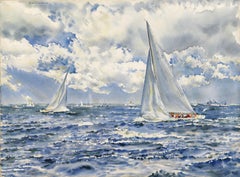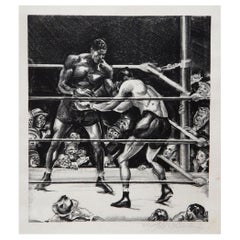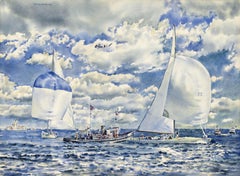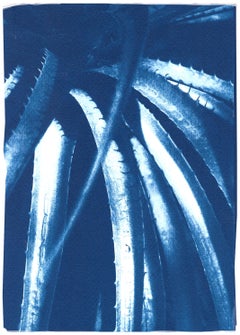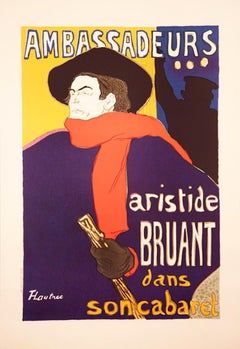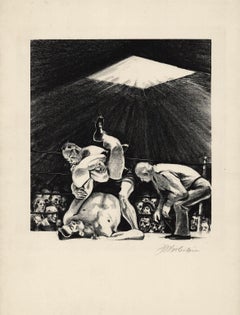Joseph Webster Golinkin Art
American, 1896-1977
JOSEPH WEBSTER GOLINKIN (1896-1977)
Painter, printmaker, naval officer, politician, environmentalist, and philanthropist. He was a true Renaissance man – excelling in everything he pursued.
Joseph Golinkin was born in Chicago on September 10, 1896, and studied at the Art Institute of Chicago. He entered the United States Naval Academy and, upon graduation, was commissioned as an Ensign and immediately deployed to serve in World War I. He remained in the Navy until 1922, when he resigned his commission to pursue his original career as an artist. He remained, however, in the active reserve as a Lieutenant Commander.
After leaving the Navy, Golinkin moved to New York, where he studied at the Art Students League with Ash Can school artist George Luks. The two artists became fast friends, and Luks introduced him to many other artists. During the 1920s and 1930s, Golinkin exhibited with several other well-known artists, including George Bellows, Joseph Margulies, and David Shotwell. He was also represented by several renowned dealers in New York City, including Ferargil Galleries, Macbeth Gallery, and Van der Straeten. He had one-person shows at the Museum of the City of New York, the Macbeth Gallery, Ferargil Galleries, Gump's in San Francisco, the San Francisco Art Gallery, and the Los Angeles Olympics in 1984. His works are part of many museum collections, including the Metropolitan Museum, New York Public Library, Museum of the City of New York, Library of Congress, and the Art Institute of Chicago.
As an artist, Golinkin worked in many mediums, including painting, watercolor, and lithography. While his subjects varied, two would dominate his work – scenes of New York and sports. He produced a large body of prints, drawings, and lithographs surrounding these two subjects. His images of New York include scenes of both city life and the structures, capturing the ambiance of the late 1920s and early 1930s.
The sporting events Golinkin depicted include baseball, bicycle racing, bowling, boxing, football, hockey, horse racing, horse shows, golf, polo, tennis, track and field, wrestling, and yacht racing. He was awarded the Gold Medal for Artistic Excellence in Relation to Sport at the X Olympiad in 1932 and again at the XI Olympiad in 1936. Golinkin's sporting scenes have been reproduced as posters for several Olympic Games. His work is also in the collections of the Baseball Hall of Fame, the Palm Beach Polo Club, Madison Square Garden, numerous yacht clubs, and in the personal collections of well-known athletes and sports enthusiasts throughout the world.
When the Navy reactivated him in 1938, his artistic career was put on hold. He served with great distinction during WWII, was awarded the Bronze Star, and retired from the Navy in 1958 with the rank of Rear Admiral. His other careers include serving for twelve years as Mayor of Centre Island, New York. As an early environmentalist, he formed a nonpartisan civic association that successfully opposed building a Robert Moses proposed bridge that would have connected Oyster Bay and Rye, New York.to
1
5
2
Overall Width
to
Overall Height
to
8
5
2
5
3
6
3
2
2
2
2
2
2
1
1
1
1
1
1
3
3
3
2
1
8
9,514
2,696
1,375
1,361
2
4
8
Artist: Joseph Webster Golinkin
Joe Louis vs. Max Baer at Yankee Stadium
By Joseph Webster Golinkin
Located in New York, NY
LOUIS & BAER AT YANKEE STADIUM.
This lithograph from circa 1935 was printed in an edition of 50. This particular impression is signed in pencil and inscribed “25/50.” The image size is 15 7/8 x 19 ¾ inches and the paper (sheet) size is 19 1/8 x 22 7/8 inches. There are two small purple estate stamps on verso.
"I define fear as standing across the ring from Joe Louis and knowing he wants to go home early." – Max Baer...
Category
1930s Naturalistic Joseph Webster Golinkin Art
Materials
Lithograph
Joseph Webster Golinkin, On the Dock, Banana Boat, New Orleans
By Joseph Webster Golinkin
Located in New York, NY
Chicago-born Golinkin studied at the Artist Students League with George Luks. After working as an illustrator for New York papers he joined the Navy in 1939 and retired as a Rear Adm...
Category
1930s Ashcan School Joseph Webster Golinkin Art
Materials
Lithograph
Wrestling [untitled].
By Joseph Webster Golinkin
Located in New York, NY
“WRESTLING” is a watercolor by Joseph Golinkin created circa 1940. This piece is painted to the paper's edge and signed in red paint in the upper left. The watercolor paper size is 20 7/8 x 15 ¾ inches. Joseph Webster Golinkin...
Category
1930s Naturalistic Joseph Webster Golinkin Art
Materials
Watercolor, Graphite
AMERICA'S CUP - 1967. BEAT TO THE FINISH - INTREPID (USA) VS. DAME PATTIE (AUS)
By Joseph Webster Golinkin
Located in New York, NY
AMERICA'S CUP - 1967. BEAT TO THE FINISH - INTREPID (USA) VS. DAME PATTIE (AUS).
“Beat to the Finish” is a 1967 watercolor by Joseph Webster ...
Category
1960s Naturalistic Joseph Webster Golinkin Art
Materials
Watercolor
Joseph Golinkin Original Lithograph, 1935, Louis-Baer Boxing Match
By Joseph Webster Golinkin
Located in Phoenix, AZ
This is an original lithograph by Chicago/New York artist and illustrator Joseph Webster Golinkin (1896-1977). This print is no. 12 of the edition of 50.
The print depicts the Joe Lo...
Category
1930s Joseph Webster Golinkin Art
Materials
Paper
America's Cup - 1967. Wing Mark, Intrepid and Dame Pattie.
By Joseph Webster Golinkin
Located in New York, NY
AMERICA'S CUP - 1967. WING MARK. INTREPID - DAME PATTIE [AUS].
This Joseph Webster Golinkin watercolor of the 1967 America's Cup depicts the...
Category
1960s Naturalistic Joseph Webster Golinkin Art
Materials
Watercolor
"Polo Scene"
By Joseph Webster Golinkin
Located in Bristol, CT
Classic c1930s polo field scene by Joseph Webster Golinkin (1896-1977)
Art Sz: 10 1/4"H x 14 3/4"W
Frame Sz: 15 1/2"H x 20"W
Joseph Webster Golinkin (September 10, 1896 – Septembe...
Category
1930s Joseph Webster Golinkin Art
Materials
Lithograph
"Four Polo Players At The International Cup"
By Joseph Webster Golinkin
Located in Bristol, CT
Classic colour print by Joseph Golinkin (1896-1977) of the US vs England at the International Polo Cup
Art Sz: 10 1/4"H x 13 1/4"W
Frame Sz: 15 1/2"H...
Category
20th Century Joseph Webster Golinkin Art
Materials
Paper
Related Items
Jurassic Aloe Leaves, Botanical Cyanotype on Paper, Blue Plants, Nature Details
By Kind of Cyan
Located in Barcelona, ES
This is an exclusive handprinted limited edition cyanotype of a beautiful Aloe plant.
Details:
+ Title: Jurassic Aloe Leaves
+ Year: 2022
+ Edition Size: 100
+ Stamped and Certifica...
Category
2010s Naturalistic Joseph Webster Golinkin Art
Materials
Photographic Film, Emulsion, Watercolor, Archival Paper, Photographic Pa...
Ambassadeurs - Aristide Bruant (after) Henri de Toulouse-Lautrec, 1966
By (After) Henri Toulouse Lautrec
Located in New York, NY
This lithographic poster illustrates Aristide Bruant who was a famous performer and cabaret owner in Paris at the turn of the 20th century. Lautrec, seizing on Bruant's trademark cos...
Category
Late 19th Century Post-Impressionist Joseph Webster Golinkin Art
Materials
Lithograph
France World Cup Lithograph by Aldo Luongo c.1998
By Aldo Luongo
Located in San Francisco, CA
FRANCE World Cup Lithograph by Aldo Luongo c.1998
Limited edition France 98' World Cup - Official License
From a very limited edition of 300.
Pencil signed lower right. Edition 24/300 lower left.
This is a rare, very small edition lithograph for the 1998 Soccer World Cup...
Category
Late 20th Century Impressionist Joseph Webster Golinkin Art
Materials
Lithograph
Marc Chagall - Inspiration - Original Lithograph from "Chagall Lithographe" v. 2
By Marc Chagall
Located in Collonge Bellerive, Geneve, CH
Marc Chagall
Original Lithograph from Chagall Lithographe 1957-1962. VOLUME II.
1963
Dimensions: 32 x 24 cm
From the unsigned edition of 10000 copies without margins
Reference: Mourlot 398
Condition : Excellent
Marc Chagall (born in 1887)
Marc Chagall was born in Belarus in 1887 and developed an early interest in art. After studying painting, in 1907 he left Russia for Paris, where he lived in an artist colony on the city’s outskirts. Fusing his own personal, dreamlike imagery with hints of the fauvism and cubism popular in France at the time, Chagall created his most lasting work—including I and the Village (1911)—some of which would be featured in the Salon des Indépendants exhibitions. After returning to Vitebsk for a visit in 1914, the outbreak of WWI trapped Chagall in Russia. He returned to France in 1923 but was forced to flee the country and Nazi persecution during WWII. Finding asylum in the U.S., Chagall became involved in set and costume design before returning to France in 1948. In his later years, he experimented with new art forms and was commissioned to produce numerous large-scale works. Chagall died in St.-Paul-de-Vence in 1985.
The Village
Marc Chagall was born in a small Hassidic community on the outskirts of Vitebsk, Belarus, on July 7, 1887. His father was a fishmonger, and his mother ran a small sundries shop in the village. As a child, Chagall attended the Jewish elementary school, where he studied Hebrew and the Bible, before later attending the Russian public school. He began to learn the fundamentals of drawing during this time, but perhaps more importantly, he absorbed the world around him, storing away the imagery and themes that would feature largely in most of his later work.
At age 19 Chagall enrolled at a private, all-Jewish art school and began his formal education in painting, studying briefly with portrait artist Yehuda Pen. However, he left the school after several months, moving to St. Petersburg in 1907 to study at the Imperial Society for the Protection of Fine Arts. The following year, he enrolled at the Svanseva School, studying with set designer Léon Bakst, whose work had been featured in Sergei Diaghilev's Ballets Russes. This early experience would prove important to Chagall’s later career as well.
Despite this formal instruction, and the widespread popularity of realism in Russia at the time, Chagall was already establishing his own personal style, which featured a more dreamlike unreality and the people, places and imagery that were close to his heart. Some examples from this period are his Window Vitebsk (1908) and My Fianceé with Black Gloves (1909), which pictured Bella Rosenfeld, to whom he had recently become engaged.
The Beehive
Despite his romance with Bella, in 1911 an allowance from Russian parliament member and art patron Maxim Binaver enabled Chagall to move to Paris, France. After settling briefly in the Montparnasse neighborhood, Chagall moved further afield to an artist colony known as La Ruche (“The Beehive”), where he began to work side by side with abstract painters such as Amedeo Modigliani and Fernand Léger as well as the avant-garde poet Guillaume Apollinaire. At their urging, and under the influence of the wildly popular fauvism and cubism, Chagall lightened his palette and pushed his style ever further from reality. I and the Village (1911) and Homage to Apollinaire (1912) are among his early Parisian works, widely considered to be his most successful and representative period.
Though his work stood stylistically apart from his cubist contemporaries, from 1912 to 1914 Chagall exhibited several paintings at the annual Salon des Indépendants exhibition, where works by the likes of Juan Gris, Marcel Duchamp and Robert Delaunay were causing a stir in the Paris art world. Chagall’s popularity began to spread beyond La Ruche, and in May 1914 he traveled to Berlin to help organize his first solo exhibition, at Der Sturm Gallery. Chagall remained in the city until the highly acclaimed show opened that June. He then returned to Vitebsk, unaware of the fateful events to come.
War, Peace and Revolution
In August 1914 the outbreak of World War I precluded Chagall’s plans to return to Paris. The conflict did little to stem the flow of his creative output, however, instead merely giving him direct access to the childhood scenes so essential to his work, as seen in paintings such as Jew in Green (1914) and Over Vitebsk (1914). His paintings from this period also occasionally featured images of the war’s impact on the region, as with Wounded Soldier (1914) and Marching (1915). But despite the hardships of life during wartime, this would also prove to be a joyful period for Chagall. In July 1915 he married Bella, and she gave birth to a daughter, Ida, the following year. Their appearance in works such as Birthday (1915), Bella and Ida by the Window (1917) and several of his “Lovers” paintings give a glimpse of the island of domestic bliss that was Chagall’s amidst the chaos.
To avoid military service and stay with his new family, Chagall took a position as a clerk in the Ministry of War Economy in St. Petersburg. While there he began work on his autobiography and also immersed himself in the local art scene, befriending novelist Boris Pasternak, among others. He also exhibited his work in the city and soon gained considerable recognition. That notoriety would prove important in the aftermath of the 1917 Russian Revolution when he was appointed as the Commissar of Fine Arts in Vitebsk. In his new post, Chagall undertook various projects in the region, including the 1919 founding of the Academy of the Arts. Despite these endeavors, differences among his colleagues eventually disillusioned Chagall. In 1920 he relinquished his position and moved his family to Moscow, the post-revolution capital of Russia.
In Moscow, Chagall was soon commissioned to create sets and costumes for various productions at the Moscow State Yiddish Theater...
Category
1960s Surrealist Joseph Webster Golinkin Art
Materials
Lithograph
$1,481
H 9.45 in W 12.6 in D 0.04 in
Clemente Untitled B: surreal mythical landscape, voyage with ocean, Venus, snake
By Francesco Clemente
Located in New York, NY
A black and white, large-scale surreal mythical landscape of an ocean voyage, with a snake wrapped around a clock, a ship, Venus sculpture, greek urns, and snakes, printed in black o...
Category
1980s Contemporary Joseph Webster Golinkin Art
Materials
Lithograph
$2,975
H 26.75 in W 119.25 in
Figurative Ink Painting N.1 'Vessels' by Dmitry Samygin
By Dmitry Samygin
Located in Paris, FR
Figurative Ink on Cotton paper
Painting N.1 'Vessels' by Dmitry Samygin
H.27 x 19.5 cm
About Dmitry Samygin
Furniture and Product Designer. His approach relies on simple forms and clarity in ideas with carefully chosen materials to expose the essence of an object. His products exemplify humanistic design, comfort in everyday use and ergonomic function.
He is a prize-winner in international competitions. He has taken part in exhibitions in Paris, Milan and Moscow, collaborates with European and Russian production, architectural and design companies. Since 2021 Dmitriy's design has been presented in a permanent exhibition at the Museum of Arts and Crafts in Moscow. Dmitry's graphics and designs are in private collections all over the world.
Samygin's Awards
2023 I+D / Design Now / winner (product design & decor)
2021 Red dot / Modul
2021 I+D magazine award / Shelter (covers for the sculptures of Moscow State Architectural Museum)
2020 Best 2020 AD Russia
2019 Andrew World...
Category
21st Century and Contemporary Contemporary Joseph Webster Golinkin Art
Materials
Cotton, Paper, Ink
$711
H 10.63 in W 7.68 in D 0.04 in
Figurative Ink Painting N.2 'Vessels II' by Dmitry Samygin
By Dmitry Samygin
Located in Paris, FR
Figurative Ink on Cotton paper
Painting N.1 'Vessels II' by Dmitry Samygin
H.27 x 19.5 cm
About Dmitry Samygin
Furniture and Product Designer. His approach relies on simple forms and clarity in ideas with carefully chosen materials to expose the essence of an object. His products exemplify humanistic design, comfort in everyday use and ergonomic function.
He is a prize-winner in international competitions. He has taken part in exhibitions in Paris, Milan and Moscow, collaborates with European and Russian production, architectural and design companies. Since 2021 Dmitriy's design has been presented in a permanent exhibition at the Museum of Arts and Crafts in Moscow. Dmitry's graphics and designs are in private collections all over the world.
Samygin's Awards
2023 I+D / Design Now / winner (product design & decor)
2021 Red dot / Modul
2021 I+D magazine award / Shelter (covers for the sculptures of Moscow State Architectural Museum)
2020 Best 2020 AD Russia
2019 Andrew World...
Category
21st Century and Contemporary Contemporary Joseph Webster Golinkin Art
Materials
Cotton, Paper, Ink
$711
H 10.63 in W 7.68 in D 0.04 in
Starry Night - Limited Edition, Figurative, Contemporary, Star, Night, Child
By Charlie Mackesy
Located in Knowle Lane, Cranleigh
Starry Night is a lithograph based on a watercolour by Charlie Mackesy. The edition is limited to 150 and each piece has been signed by Charlie Mackesy...
Category
2010s Other Art Style Joseph Webster Golinkin Art
Materials
Lithograph
$3,355
H 11.82 in W 7.88 in D 0.4 in
Hand of Africa - Mandela, Former South African President, Signed Artwork, Hand
By Nelson Mandela
Located in Knowle Lane, Cranleigh
Nelson Mandela, Hand of Africa, Signed Limited Edition Lithograph
Many people are unaware that Nelson Mandela turned his hand to art in his 80's as a way of leaving a legacy for his ...
Category
Early 2000s Contemporary Joseph Webster Golinkin Art
Materials
Lithograph
$20,134
H 25.5 in W 20 in D 2 in
“Thebes, Great Hall at Karnak”
By David Roberts
Located in San Francisco, CA
This lithograph titled "Thebes, Great Hall at Karnak" is a notable work by the Scottish painter David Roberts (1796-1864). This particular scene is part of Roberts' most famous colle...
Category
1840s English School Joseph Webster Golinkin Art
Materials
Paper, Lithograph
Fenzoni, Painting AND preparatorial Drawing, John the Baptist, Italy Renaissance
By Ferrau Fenzoni
Located in Greven, DE
The painting and the preparatory drawing are offered together.
Provenance
Private collection, Germany, Trier, c. 1980- 2013
Saint John the Baptist
Brown ink and wash over red chalk on oatmeal paper
31 x 20.5 cm
Inscribed: „Ferrau Fenzonio da Faenza invt. esque … imp. da Fran. Villamena …“.
bears the collector's mark of Henry Scipio Reitlinger (1882-1950; Lugt 2274a) on a tiny label glued to the verso
On the reverse is a partial drawing of a Pieta, pricked for transfer.
Provenance
New York, Doyle, 14. October 2015, No. 6
The painting and the preparatory drawing resemble the composition of an engraving after Ferraù Fenzoni by Francesco Villamena. Drawing, engraving and painting are almost identical, except for minor differences. Even the measurements nearly correspond: painting (32 x 25,5 cm), drawing (30 x 20,5 cm), engraving (31,1 x 23,5 cm).
Dr. Guiseppe Scavizzi confirmed the attribution of the present panting to Fenzoni and he dates it to c. 1590.
The inscription on the drawing reads “Ferrau Fenzonio da Faenza invt. esque. . . imp. da Fran: Villamena . . .”. The engraving’s inscription also lists place and date “Ferra Fensionius inventor/F. Villamoena sculpsit Rome/Aspectu fruitur… antra puer/cum Privilegio… 1613”.
Interestingly, the engraving is not mirrored as it is in most printing processes. Painting, drawing and engraving are not reversed but the same. It is remarkable to note that there are further paintings by Fenzoni which were engraved in the same order and not reverted. They also show strong parallels regarding the compositions and the measurements (see for example “Deposition of Christ” ).
Ferraù Fenzoni was an Italian painter mainly active in Todi. He is also called Il Faenzone after his birthplace (Faenza). He apprenticed in Rome during the papacy of Gregory XIII and contributed to numerous fresco cycles under pope Sixtus V, such as the Loggia della Benedizioni in the Lateran Palace, the frescoes on the walls and vaults of the Scala Santa of the adjacent Basilica of San Giovanni in Laterano, and the decoration in the Sistine library. His expressive canvases straddle the styles of Mannerism and Baroque. In 1594, he moved to Todi. A “Last Judgement” by him is housed in the cathedral of Todi. He returned to Faenza in 1599, where he decorated chapels in the cathedral from 1612 to 1616. In 1622, he completed a “Deposition”, now in the local Pinacoteca. In 1640, Fenzoni was named “cavaliere dello speron d’oro” by Cardinal Colonna and, on 25th April 1634, he was nominated vicar and “castellano of Granarolo”.
Fenzoni‘s style is characterized by a mixture of the Mannerism of the Northern Netherlands and the Italian Baroque.
Saint John the Baptist, Old Master, 17th Century, By Fenzoni, Religious Scene, Rome Art...
Category
16th Century Mannerist Joseph Webster Golinkin Art
Materials
Canvas, Oil, Handmade Paper
Ferrau FenzoniFenzoni, Painting AND preparatorial Drawing, John the Baptist, Italy Renaissance, 1590
$28,453 Sale Price
25% Off
H 12.21 in W 8.08 in
Allegory of Summer - 17th Century Italian Sepia and Watercolor Drawing
Located in Stockholm, SE
A fine Italian watercolor and sepia drawing, an allegory of summer. People harvesting, eating and drinking in a hilly landscape, probably by Antonio Grano (c.1669-1718). In the fron...
Category
Late 17th Century Italian School Joseph Webster Golinkin Art
Materials
Paper, Ink, Watercolor
$1,956
H 7.56 in W 5.01 in D 0.2 in
Previously Available Items
Arm Scissors
By Joseph Webster Golinkin
Located in New York, NY
Joseph Golinkin created the lithograph entitled “Arm Scissors” circa 1938. This piece is signed in pencil, lower right, and titled and inscribed “3/50” at the lower left paper edge. The printed image size is 13.25 x 11.88 inches and the overall paper (sheet) size is 23 x 16 inches. Beautifully composed “Arm Scissors” also exudes the excitement of the moment through the spectator’s expressions and the crouched referee.
JOSEPH WEBSTER GOLINKIN...
Category
1930s Naturalistic Joseph Webster Golinkin Art
Materials
Lithograph
Joseph Webster Golinkin art for sale on 1stDibs.
Find a wide variety of authentic Joseph Webster Golinkin art available for sale on 1stDibs. If you’re browsing the collection of art to introduce a pop of color in a neutral corner of your living room or bedroom, you can find work that includes elements of green and other colors. You can also browse by medium to find art by Joseph Webster Golinkin in lithograph, paint, watercolor and more. Not every interior allows for large Joseph Webster Golinkin art, so small editions measuring 14 inches across are available. Customers who are interested in this artist might also find the work of Charles De Wolf Brownell, Henri Gadbois, and Harry Rogers. Joseph Webster Golinkin art prices can differ depending upon medium, time period and other attributes. On 1stDibs, the price for these items starts at $750 and tops out at $11,250, while the average work can sell for $2,220.
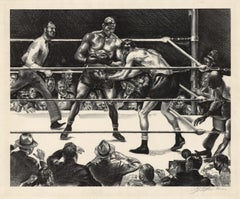
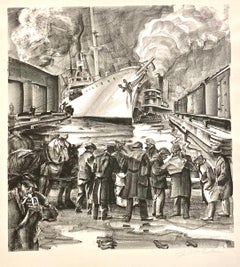
![webster town hall wrestling Wrestling [untitled].](https://a.1stdibscdn.com/a_3312/1617385178602/Golinkin_Wrestling_wc_68552_master.jpg?width=240)
